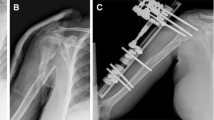Abstract
Between January 1991 and December 2002, we treated 92 acute, displaced, closed humeral shaft fractures (AO classification type A). We used three fixation methods: dynamic compression plates (DCP) in 36 patients, Ender nails (EN) in 32 patients and interlocking nails (ILN) in 24 patients. The patients were followed for a minimum of 24 months. At one year, all fractures except two (one DCP/one ILN) had united. Patients treated with EN had shorter mean operation time, 51 (35–110) min; less mean blood loss, 70 (30–170) ml and shorter mean hospital stay, 5.8 (3–12) days. There were three iatrogenic radial nerve palsies: two in the DCP group and one in the ILN group. There was one wound infection. There were three cases with impingement of the shoulder but range of motion was restored after nail removal. For patients with multiple trauma or high operative risk, EN fixation served as a safer and faster procedure. ILN fixation offered a stable fixation via a smaller incision but more fracture comminution might happen.
Résumé
Entre janvier 1991 et décembre 2002 nous avons traité chirurgicalement 92 fractures diaphysaires humérales fermés déplacés ( classification AO type A). Nous avons utilisé trois méthodes de fixation: plaque à compression dynamique (DCP) chez 36 malades, clou de Ender (EN) chez 32 malades et clou verrouillé (ILN) chez 24 malades. Les malades ont été suivis pendant un minimum de 24 mois. Àprés un an toutes les fractures sauf deux avaient consolidé (un DCP/un ILN). Les Malades traité avec EN ont eu un temps d’opération moyen plus court, 51 (35–110) min, une perte sanguine plus faible, 70 (30–170) ml et un plus court séjour à l’hôpital , 5.8 (3–12) jours. Il y avait trois paralysies iatrogènes du nerf radial, deux dans le groupe DCP et une dans le groupe ILN. Il y avait une infection. Il y avait trois cas avec un conflit de l’épaule mais l’amplitude de mouvement a été restauré après ablation du clou. Pour les malades avec multiples traumatismes ou risque opératoire élevé, l’enclouage de Ender est une procédure plus sûre et plus rapide. L’enclouage verrouillé a permit une fixation stable par une plus petite incision, mais avec un risque plus grand de comminution de la fracture.
Similar content being viewed by others
References
Ajmal M, O’Sullivan M, McCabe J, Curtin W (2001) Antegrade locked intramedullary nailing in humeral shaft fractures. Injury 32:692–694
Chapman JR, Henley MB, Agel J, Benca PJ (2000) Randomized prospective study of humeral shaft fracture fixation: intramedullary nails versus plates. J Orthop Trauma 14:162–166
Chen CM, Chiu FY, Lo WH (2000) Treatment of acute closed humeral shaft fractures with ender nails. Injury 31:683–685
Chen AL, Joseph TN, Wolinksy PR, Tejwani NC, Kummer FJ, Egol KA, Koval KJ (2002) Fixation stability of comminuted humeral shaft fractures: locked intramedullary nailing versus plate fixation. J Trauma 53:733–737
Chiu FY, Chen CM, Lin CFJ, Lo WH, Huang YL, Chen TH (1997) Closed humeral shaft fractures: a prospective evaluation of surgical treatment. J Trauma 43:947–951
Fernandez FF, Matschke S, Hulsenbeck A, Egenolf M, Wentzensen A (2004) Five years’ clinical experience with the undreamed humeral nail in the treatment of humeral shaft fractures. Injury 35:264–271
Flinkkila T, Hyvonen P, Lakovaara M, Linden T, Ristiniemi J, Hamalainen M (1999) Intramedullary nailing of humeral shaft fractures. A retrospective study of 126 cases. Acta Orthop Scand 70:133–136
Hall RF, Pankovich AM (1987) Ender nailing of acute fractures of the humerus. J Bone Joint Surg Am 69:558–567
Kumar A, Sadiq SA (2002) Non-union of the humeral shaft treated by internal fixation. Int Orthop 26:214–216
Liebergall M, Jaber S, Laster M, Abu-Snieneh K, Mattan Y, Segal D (1997) Ender nailing of acute humeral shaft fractures in multiple injuries. Injury 28:577–580
Lin J (1998) Treatment of humeral shaft fractures with humeral locked nail and comparison with plate fixation. J Trauma 44:859–864
Lin J, Hou SM (2003) Locked nailing of severely comminuted or segmental humeral fractures. Clin Orthop 406:195–204
Lin J, Shen PW, Hou SM (2003) Complications of locked nailing in humeral shaft fractures. J Trauma 54:943–949
Martinez AA, Cuenca J, Herrera A (2004) Treatment of humeral shaft nonunions: nailing versus plating. Arch Orthop Trauma Surg 124:92–95
McCormack RG, Brien D, Buckley RE, Mckee MD, Powell J, Schemitsch EH (2000) Fixation of fractures of the shaft of the humerus by dynamic compression plate or intramedullary nail: a prospective, randomized trial. J Bone Joint Surg Br 82:336–339
Rodriguez-Merchan EC (1996) Hackethal nailing in closed transverse humeral shaft fractures after failed manipulation. Int Orthop 20:134–136
Sanzana ES, Dümmer RE, Castro JP, Díaz EA (2002) Intramedullary nailing of humeral shaft fractures. Int Orthop 26:211–213
Sarmiento A, Zagorski JB, Zych GA, Latta LL, Capps CA (2000) Functional bracing for the treatment of fractures of the humeral diaphysis. J Bone Joint Surg Am 82:478–486
Simon P, Jobard D, Bistour L, Babin SR (1999) Complications of Marchetti locked nailing for humeral shaft fractures. Int Orthop 23:320–324
Wallny T, Sagebiel C, Westerman K, Wagner UA, Reimer M (1997) Comparative results of bracing and interlocking nailing in the treatment of humeral shaft fractures. Int Orthop 21:374–379
Wenzl ME, Porte T, Fuchs S, Faschingbauer M, Jurgens C (2004) Delayed union and non-union of the humeral diaphysis—compression plate or internal plate fixation. Injury 35:55–60
Author information
Authors and Affiliations
Corresponding author
Rights and permissions
About this article
Cite this article
Chao, TC., Chou, WY., Chung, JC. et al. Humeral shaft fractures treated by dynamic compression plates, Ender nails and interlocking nails. International Orthopaedics (SICOT) 29, 88–91 (2005). https://doi.org/10.1007/s00264-004-0620-8
Received:
Accepted:
Published:
Issue Date:
DOI: https://doi.org/10.1007/s00264-004-0620-8




